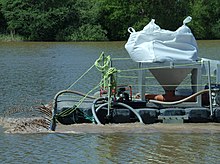Eutrophication

| Part of a series on |
| Plankton |
|---|
 |
Eutrophication is a general term describing a process in which
Approaches for prevention and reversal of eutrophication include minimizing point source pollution from sewage and agriculture as well as other nonpoint pollution sources.[1] Additionally, the introducution of bacteria and algae-inhibiting organisms such as shellfish and seaweed can also help reduce nitrogen pollution, which in turn controls the growth of cyanobacteria, the main source of harmful algae blooms.[5]
History and terminology
This section needs expansion. You can help by adding to it. (February 2024) |
The term "eutrophication" comes from the
Eutrophication was recognized as a water pollution problem in European and North American lakes and reservoirs in the mid-20th century.[9] Breakthrough research carried out at the Experimental Lakes Area (ELA) in Ontario, Canada, in the 1970s provided the evidence that freshwater bodies are phosphorus-limited. ELA uses the whole ecosystem approach and long-term, whole-lake investigations of freshwater focusing on cultural eutrophication.[10]
Causes

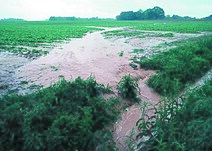
Eutrophication is caused by excessive concentrations of nutrients, most commonly phosphates and nitrates,[11] although this varies with location. Prior to their being phasing out in the 1970's, phosphate-containing detergents contributed to eutrophication. Since then, sewage and agriculture have emerged as the dominant phosphate sources.[12] The main sources of nitrogen pollution are from agricultural runoff containing fertilizers and animal wastes, from sewage, and from atmospheric deposition of nitrogen originating from combustion or animal waste.[13]
The limitation of productivity in any aquatic system varies with the rate of supply (from external sources) and removal (flushing out) of nutrients from the body of water.[14] This means that some nutrients are more prevalent in certain areas than others and different ecosystems and environments have different limiting factors. Phosphorus is the limiting factor for plant growth in most freshwater ecosystems,[15] and because phosphate adheres tightly to soil particles and sinks in areas such as wetlands and lakes,[16] due to its prevalence nowadays more and more phosphorus is accumulating inside freshwater bodies.[17][18] In marine ecosystems, nitrogen is the primary limiting nutrient; nitrous oxide (created by the combustion of fossil fuels) and its deposition in the water from the atmosphere has led to an increase in nitrogen levels,[19] and also the heightened levels of eutrophication in the ocean.[20]
Cultural eutrophication
Cultural or anthropogenic eutrophication is the process that causes eutrophication because of human activity.[21][22] The problem became more apparent following the introduction of chemical fertilizers in agriculture (green revolution of the mid-1900s).[23] Phosphorus and nitrogen are the two main nutrients that cause cultural eutrophication as they enrich the water, allowing for some aquatic plants, especially algae to grow rapidly and bloom in high densities. Algal blooms can shade out benthic plants thereby altering the overall plant community.[24] When algae die off, their degradation by bacteria removes oxygen, potentially, generating anoxic conditions. This anoxic environment kills off aerobic organisms (e.g. fish and invertebrates) in the water body. This also affects terrestrial animals, restricting their access to affected water (e.g. as drinking sources). Selection for algal and aquatic plant species that can thrive in nutrient-rich conditions can cause structural and functional disruption to entire aquatic ecosystems and their food webs, resulting in loss of habitat and species biodiversity.[25]
There are several sources of excessive nutrients from human activity including run-off from fertilized fields, lawns, and golf courses, untreated sewage and wastewater and internal combustion of fuels creating nitrogen pollution.[26] Cultural eutrophication can occur in fresh water and salt water bodies, shallow waters being the most susceptible. In shore lines and shallow lakes, sediments are frequently resuspended by wind and waves which can result in nutrient release from sediments into the overlying water, enhancing eutrophication.[27] The deterioration of water quality caused by cultural eutrophication can therefore negatively impact human uses including potable supply for consumption, industrial uses and recreation.[28]

Natural eutrophication
Eutrophication can be a natural process and occurs naturally through the gradual accumulation of sediment and nutrients. Naturally, eutrophication is usually caused by the natural accumulation of nutrients from dissolved phosphate minerals and dead plant matter in water.[29][30]
Natural eutrophication has been well-characterized in lakes. Paleolimnologists now recognise that climate change, geology, and other external influences are also critical in regulating the natural productivity of lakes. A few artificial lakes also demonstrate the reverse process (meiotrophication[31]), becoming less nutrient rich with time as nutrient poor inputs slowly elute the nutrient richer water mass of the lake.[32][33] This process may be seen in artificial lakes and reservoirs which tend to be highly eutrophic on first filling but may become more oligotrophic with time. The main difference between natural and anthropogenic eutrophication is that the natural process is very slow, occurring on geological time scales.[34]
Effects

Ecological effects
Eutrophication can have the following ecological effects: increased biomass of
, loss of desirable fish species.Decreased biodiversity
When an ecosystem experiences an increase in nutrients,
New species invasion
Eutrophication may cause competitive release by making abundant a normally
Toxicity
Some
Economic effects
Eutrophication and harmful algal blooms can have economic impacts due to increasing water treatment costs, commercial fishing and shellfish losses, recreational fishing losses (reductions in harvestable fish and shellfish), and reduced tourism income (decreases in perceived aesthetic value of the water body).[41] Water treatment costs can be increased due to decreases in water transparency (increased turbidity). There can also be issues with color and smell during drinking water treatment.
Health impacts
Human health effects include excess nitrate in drinking water (blue baby syndrome); disinfection by-products in drinking water.[42] Swimming in water affected by a harmful algal bloom can cause skin rashes and respiratory problems.[43]
Causes and effects for different types of water bodies
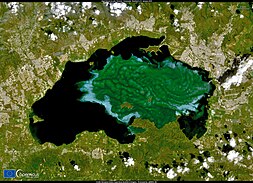
Freshwater systems
One response to added amounts of nutrients in aquatic ecosystems is the rapid growth of microscopic algae, creating an algal bloom. In freshwater ecosystems, the formation of floating algal blooms are commonly nitrogen-fixing cyanobacteria (blue-green algae). This outcome is favored when soluble nitrogen becomes limiting and phosphorus inputs remain significant.[44] Nutrient pollution is a major cause of algal blooms and excess growth of other aquatic plants leading to overcrowding competition for sunlight, space, and oxygen. Increased competition for the added nutrients can cause potential disruption to entire ecosystems and food webs, as well as a loss of habitat, and biodiversity of species.[25]
When overproduced
Enhanced growth of aquatic vegetation, phytoplankton and algal blooms disrupts normal functioning of the ecosystem, causing a variety of problems such as a lack of
Phosphorus is often regarded as the main culprit in cases of eutrophication in lakes subjected to "point source" pollution from sewage pipes. The concentration of algae and the trophic state of lakes correspond well to phosphorus levels in water. Studies conducted in the Experimental Lakes Area in Ontario have shown a relationship between the addition of phosphorus and the rate of eutrophication. Later stages of eutrophication lead to blooms of nitrogen-fixing cyanobacteria limited solely by the phosphorus concentration.[49] Phosphorus-base eutrophication in fresh water lakes has been addressed in several cases.
Coastal waters
-
Map of measured Gulf hypoxia zone, July 25–31, 2021, LUMCON-NOAA
-
Oxygen minimum zones (OMZs) (blue) and areas with coastal hypoxia (red) in the world's ocean[50]
Eutrophication is a common phenomenon in
Examples of anthropogenic sources of nitrogen-rich pollution to coastal waters include sea cage fish farming and discharges of ammonia from the production of coke from coal.[53] In addition to runoff from land, wastes from fish farming and industrial ammonia discharges, atmospheric fixed nitrogen can be an important nutrient source in the open ocean. This could account for around one third of the ocean's external (non-recycled) nitrogen supply, and up to 3% of the annual new marine biological production.[54]
Coastal waters embrace a wide range of
Nutrients are supplied to coastal waters from land via river and groundwater and also via the atmosphere. There is also an important source from the open ocean, via mixing of relatively nutrient rich deep ocean waters.[55] Nutrient inputs from the ocean are little changed by human activity, although climate change may alter the water flows across the shelf break. By contrast, inputs from land to coastal zones of the nutrients nitrogen and phosphorus have been increased by human activity globally. The extent of increases varies greatly from place to place depending on human activities in the catchments.[56][57] A third key nutrient, dissolved silicon, is derived primarily from sediment weathering to rivers and from offshore and is therefore much less affected by human activity.
Effects of coastal eutrophication
These increasing nitrogen and phosphorus nutrient inputs exert eutrophication pressures on coastal zones. These pressures vary geographically depending on the catchment activities and associated nutrient load. The geographical setting of the coastal zone is another important factor as it controls dilution of the nutrient load and oxygen exchange with the atmosphere. The effects of these eutrophication pressures can be seen in several different ways:
- There is evidence from satellite monitoring that the amounts of chlorophyll as a measure of overall phytoplankton activity are increasing in many coastal areas worldwide due to increased nutrient inputs.[58]
- The phytoplankton species composition may change due to increased nutrient loadings and changes in the proportions of key nutrients. In particular the increases in nitrogen and phosphorus inputs, along with much smaller changes in silicon inputs, create changes in the ratio of nitrogen and phosphorus to silicon. These changing nutrient ratios drive changes in phytoplankton species composition, particularly disadvantaging silica rich phytoplankton species like diatoms compared to other species.[55] This process leads to the development of nuisance algal blooms in areas such as the North Sea[59] (see also OSPAR Convention) and the Black Sea.[60] In some cases nutrient enrichment can lead to harmful algal blooms (HABs). Such blooms can occur naturally, but there is good evidence that these are increasing as a result of nutrient enrichment, although the causal linkage between nutrient enrichment and HABs is not straightforward.[61]
- Oxygen depletion has existed in some coastal seas such as the Baltic for thousands of years. In such areas the density structure of the water column severely restricts water column mixing and associated oxygenation of deep water. However, increases in the inputs of bacterially degradable organic matter to such isolated deep waters can exacerbate such oxygen depletion in oceans. These areas of lower dissolved oxygen have increased globally in recent decades. They are usually connected with nutrient enrichment and resulting algal blooms.[50] Climate change will generally tend to increase water column stratification and so exacerbate this oxygen depletion problem.[62] An example of such coastal oxygen depletion is in the Gulf of Mexico where an area of seasonal anoxia more than 5000 square miles in area has developed since the 1950s. The increased primary production driving this anoxia is fueled by nutrients supplied by the Mississippi river.[63] A similar process has been documented in the Black Sea.[60]
- primary producers can increase rates of respiration in the hypolimnion. If oxygen depletion becomes extreme, aerobic organisms (such as fish) may die, resulting in what is known as a "summer kill".[64]
Extent of the problem
Surveys showed that 54% of lakes in Asia are eutrophic; in Europe, 53%; in North America, 48%; in South America, 41%; and in Africa, 28%.[65] In South Africa, a study by the CSIR using remote sensing has shown more than 60% of the reservoirs surveyed were eutrophic.[66]
The World Resources Institute has identified 375 hypoxic coastal zones in the world, concentrated in coastal areas in Western Europe, the Eastern and Southern coasts of the US, and East Asia, particularly Japan.[67]
Prevention
As a society, there are certain steps we can take to ensure the minimization of eutrophication, thereby reducing its harmful effects on humans and other living organisms in order to sustain a healthy norm of living, some of which are as follows:
Minimizing pollution from sewage
There are multiple different ways to fix cultural eutrophication with raw sewage being a point source of pollution. For example, sewage treatment plants can be upgraded for biological nutrient removal so that they discharge much less nitrogen and phosphorus to the receiving water body. However, even with good secondary treatment, most final effluents from sewage treatment works contain substantial concentrations of nitrogen as nitrate, nitrite or ammonia. Removal of these nutrients is an expensive and often difficult process.
Laws regulating the discharge and treatment of sewage have led to dramatic nutrient reductions to surrounding ecosystems.[68] Because a major contributor to the nonpoint source nutrient loading of water bodies is untreated domestic sewage, it is necessary to provide treatment facilities to highly urbanized areas, particularly those in developing countries, in which treatment of domestic waste water is a scarcity. The technology to safely and efficiently reuse wastewater, both from domestic and industrial sources, should be a primary concern for policy regarding eutrophication.
Minimizing nutrient pollution by agriculture
There are many ways to help fix cultural eutrophication caused by agriculture. Some recommendations issued by the U.S. Department of Agriculture:[69]
- Nutrient Management Techniques - Anyone using fertilizers should apply fertilizer in the correct amount, at the right time of year, with the right method and placement. Organically fertilized fields can "significantly reduce harmful nitrate leaching" compared to conventionally fertilized fields.[70] Eutrophication impacts are in some cases higher from organic production than they are from conventional production.[71] In Japan the amount of nitrogen produced by livestock is adequate to serve the fertilizer needs for the agriculture industry.[72]
- Year - Round Ground Cover - a cover crop will prevent periods of bare ground thus eliminating erosion and runoff of nutrients even after the growing season has occurred.
- Planting Field Buffers - By planting trees, shrubs and grasses along the edges of fields to help catch the runoff and absorb some nutrients before the water makes it to a nearby water body.Riparian buffer zones are interfaces between a flowing body of water and land, and have been created near waterways in an attempt to filter pollutants; sediment and nutrients are deposited here instead of in water. Creating buffer zones near farms and roads is another possible way to prevent nutrients from traveling too far. Still, studies have shown[74]that the effects of atmospheric nitrogen pollution can reach far past the buffer zone. This suggests that the most effective means of prevention is from the primary source.
- Conservation Tillage - By reducing frequency and intensity of tilling the land will enhance the chance of nutrients absorbing into the ground.
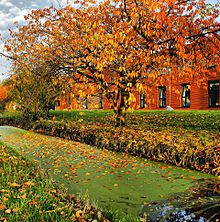
Policy
The United Nations framework for Sustainable Development Goals recognizes the damaging effects of eutrophication for marine environments. It has established a timeline for creating an Index of Coastal Eutrophication and Floating Plastic Debris Density (ICEP) within Sustainable Development Goal 14 (life below water).[75] SDG 14 specifically has a target to: "by 2025, prevent and significantly reduce marine pollution of all kinds, in particular from land-based activities, including marine debris and nutrient pollution".[76]
Policy and regulations are a set of tools to minimize causes of eutrophication.[77] Nonpoint sources of pollution are the primary contributors to eutrophication, and their effects can be minimized through common agricultural practices. Reducing the amount of pollutants that reach a watershed can be achieved through the protection of its forest cover, reducing the amount of erosion leeching into a watershed. Also, through the efficient, controlled use of land using sustainable agricultural practices to minimize land degradation, the amount of soil runoff and nitrogen-based fertilizers reaching a watershed can be reduced.[78] Waste disposal technology constitutes another factor in eutrophication prevention.
Because a body of water can have an effect on a range of people reaching far beyond that of the watershed, cooperation between different organizations is necessary to prevent the intrusion of contaminants that can lead to eutrophication. Agencies ranging from state governments to those of water resource management and non-governmental organizations, going as low as the local population, are responsible for preventing eutrophication of water bodies. In the United States, the most well known inter-state effort to prevent eutrophication is the Chesapeake Bay.[79]
Reversal and remediation
Reducing nutrient inputs is a key precondition for restoration, but there are two caveats: Firstly it can take a long time, particularly because of the storage of nutrients in sediments. Secondly, restoration may need more than a simple reversal of inputs since there are sometimes several stable but very different ecological states.[80] Recovery of eutrophicated lakes is slow, often requiring several decades.[18]
In
Algae Bloom Forecasting
The National Oceanic Atmospheric Admiration in the United States has created a forecasting tool for regions such as the Great Lakes.[81]
Nutrient bioextraction
Nutrient bioextraction is bioremediation involving cultured plants and animals. Nutrient bioextraction or bioharvesting is the practice of farming and harvesting shellfish and seaweed for the purpose of removing nitrogen and other nutrients from natural water bodies.[82]
Shellfish in estuaries
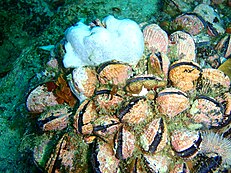


![Oxygen minimum zones (OMZs) (blue) and areas with coastal hypoxia (red) in the world's ocean[50]](http://upload.wikimedia.org/wikipedia/commons/thumb/7/7e/UNESCO_global_ocean_deoxygenation_map.png/553px-UNESCO_global_ocean_deoxygenation_map.png)
